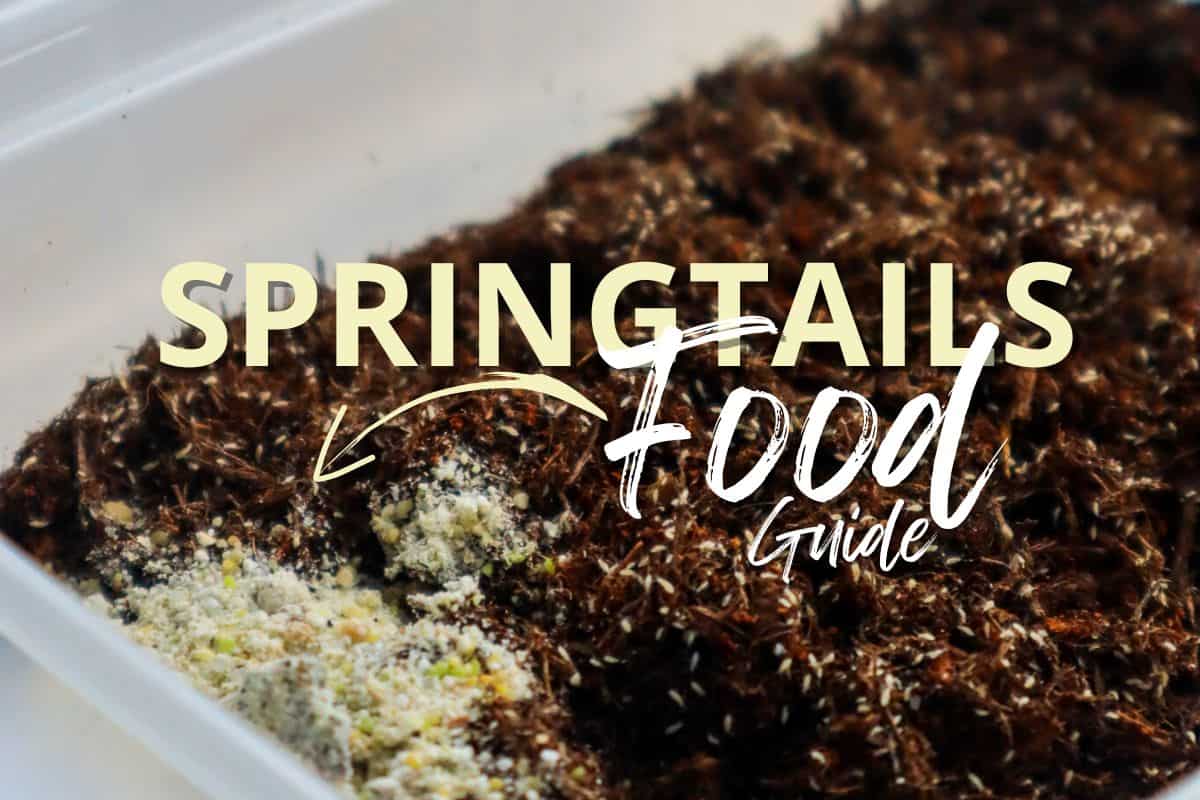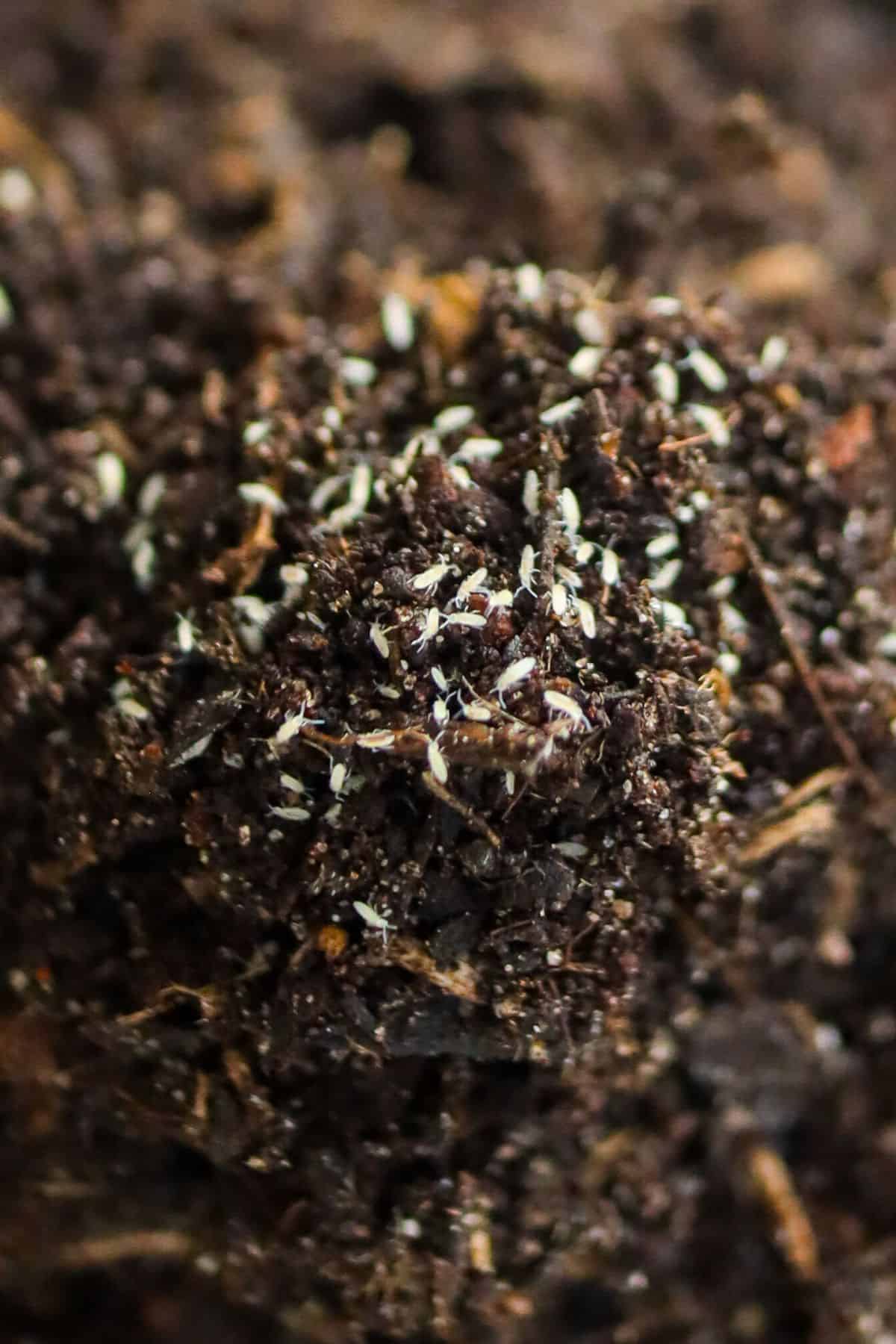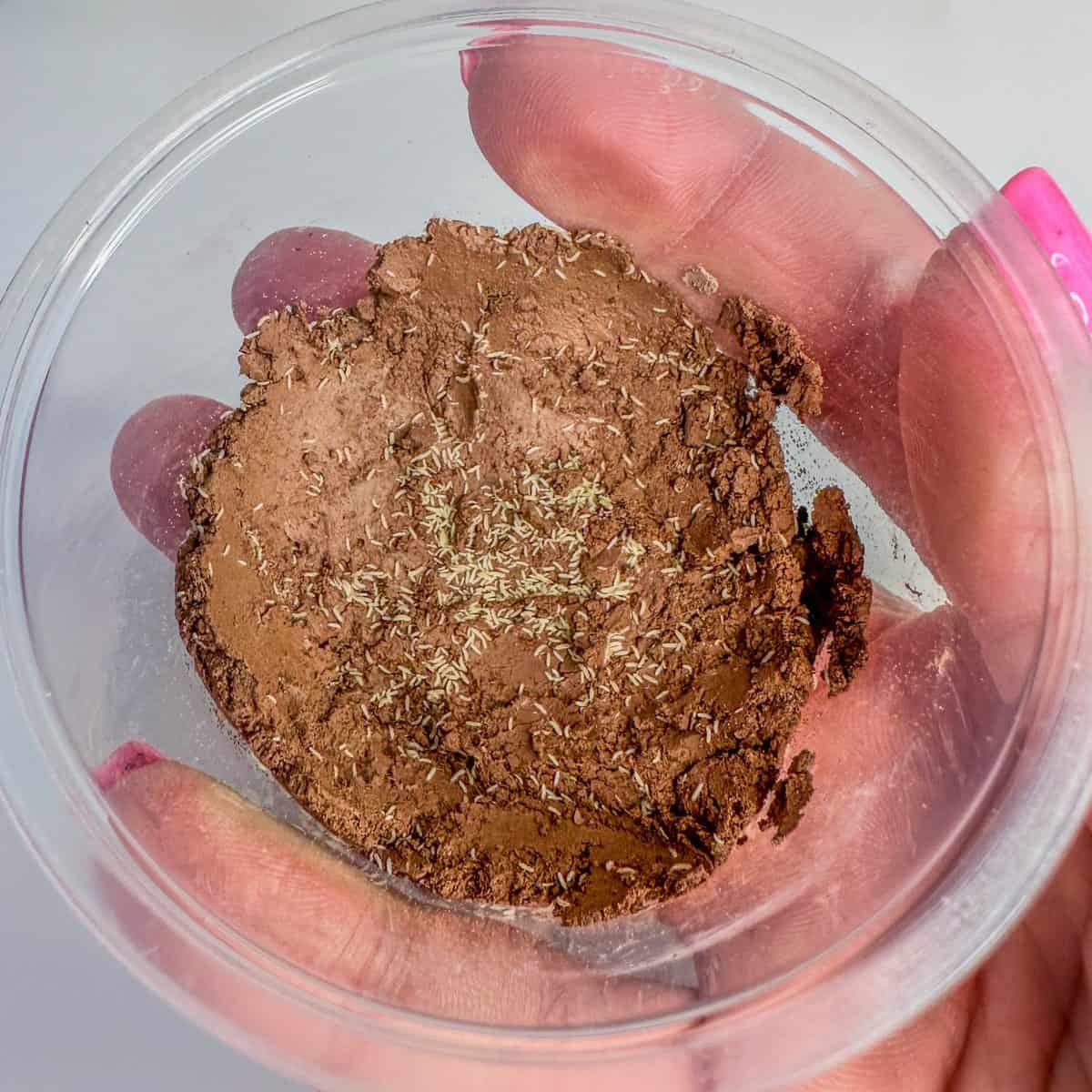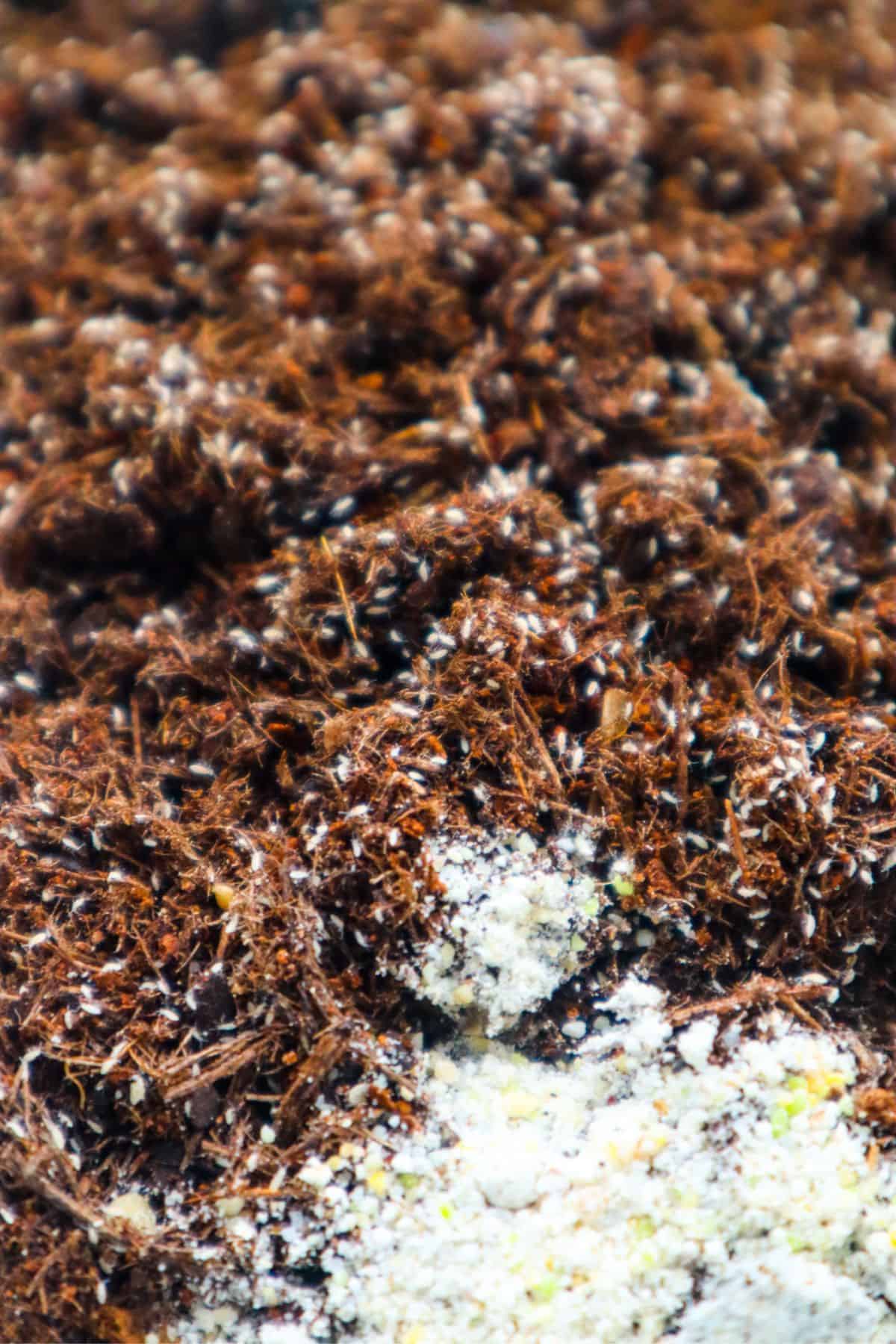Springtails are fast becoming a terrarium mainstay for their bioactive abilities.
All of which comes down to their distinctive diets.
In short, these little critters love to feast on many of the things we don’t want in our terrariums. But there are some common misconceptions about what they’re able to process.
In this guide, we’ll cover exactly what springtails can (and cannot) eat and what you might want to feed them if you want to grow a healthy culture.
Let’s spring in to action!

Terrarium Tribe is reader-supported. When you purchase through links on our site, we may earn an affiliate commission (at no further cost to you). 💜
What Do Springtails Eat in Nature?
As with every member of the bioactive cleanup crew, springtails are denoted as “detrivores.”
Species that feed on decomposing organic matter, whether that be fallen leaves, animal waste, or just about anything else found on the forest floor.
But if we look a little closer, they’re not so much eating the organic material itself – they’re eating what’s growing on it!
Springtails like to eat the mold, mildew, and bacteria that grow on decomposing materials.1
That’s what makes terrarium springtails such an effective bioactive solution, as their primary food is precisely what we want to keep at bay.

This little crew will happily go to work cleaning up all of your surfaces.
As long as you have a steady supply of decomposing organic materials, your springtails will be happy. You can facilitate this by adding bioactive materials like leaf litter and softwoods like cholla wood (and to a lesser extent, cork bark).
In a terrarium, springtails may need a little food booster in the early stages of a fresh terrarium, as (hopefully) nothing should be breaking down just yet.

👉 Shop temperate white springtails on our shop.
So next, we’ll cover how to optimize their food for best results.
What to Feed Springtails
When we’re looking at what to feed springtails, it’s less about the food itself and more about how it interacts with a warm and wet environment,
Remember, springtails don’t really eat the food itself; they eat what grows on it. So, generally speaking, we’re looking for nutritious foods that will rapidly form a biofilm.
It’s kind of saying food that will mold over quickly, but just throwing in a bunch of moldy food is a recipe for disaster.
There are better ways to do this – here’s what to look for in potential springtail foods.
- Dry foods often tend to be better than wet foods. Springtails like moist foods, but adding a big wet chunk of fruit can be unpredictable in terms of how much – and what type of – mold it’ll produce. It’s easier to use dry foods and add moisture appropriately (a quick spray of water should do it) to control the growth. Not to mention the fact that fruit tends to attract pests – no thanks.
- Powders efficiently form biofilms thanks to their high surface area. Plus, they’re a convenient solution in terms of storage and dosing. Just a few sprinkles at a time is usually enough. Small particulate foods like rice can work too, but grains are best avoided as they also seem to attract pests (as do grain-based foods like dog/cat food).
- Springtails do best when given a source of protein as well as carbohydrates. Extra points if that contains minerals and other micronutrients too!

So, what are the most common foods to feed springtails? Plus, their pros and cons.
- 1. Brewer’s yeast is an all-in-one choice that’s affordable and easy to source. Full of protein, vitamins, and minerals, it’s perfect for springtails (and it’s used as a supplement for people, too). It can produce CO2 though, so I wouldn’t recommend this in small containers.
- 2. Fish flakes are formulated as a complete nutrition source for fish, and so they contain a balanced blend of carbohydrates and protein. They’re often used for springtails, though I hear anecdotal evidence that they can attract pests.
- 3. Dedicated springtail foods such as ours.

Springtail Food Recipe
I’ve seen a variety of springtail food recipes shared online.
To me, there are two main reasons to approach a recipe vs. a single food.
- You want to optimize the food to the highest degree.
- You want to maximize the amount of food using readily available ingredients.
Either way, making your own springtail food at home isn’t particularly difficult.
A highly optimized (and very simple recipe) would be to supplement brewer’s yeast with some further nutrient-dense powders, e.g., powdered greens or spirulina.
Alternatively, you can make your own homemade springtail food recipe by blitzing a variety of ingredients down to a fine powder. There’s certainly something to be said for providing a varied diet, and this can easily be done in bulk.
Many of the things you might already find in your cupboards would work; just make sure it’s dry!
- A carb source, e.g., dried vegetables, rice, oats, flour.
- A protein source, e.g., dried beans, shrimp powder.
The more nutrient-dense – both in terms of macronutrients and micronutrients – the better. (For reference, our blend has multiple veggie, protein and calcium sources).
Where to Find Springtail Food for Sale
Of course, you can find brewer’s yeast and the like at your local supermarkets, but for optimized springtail blends, you’ll have to go to the experts. We’ve teamed up with Rubber Ducky Isopods to sell their propriety blend directly on our site.
👉 Check out our springtail food for sale.
Feeding Isopods and Springtails Together
Feeding springtails is undoubtedly easier when you have isopods in the mix.
Isopods take care of the actual food, and the springtails take care of the mold that grows on it. It’s nice to have the balance, and they tend to buffer each other so nothing gets out of hand, e.g., leftover food rotting or severe mold blooms.
Plus, they both have similar nutritional needs – isopod food and springtail food are often sold as the same product, which is the case for ours, too; the blend works for both.
Finally, it also opens up your food options somewhat. In that, you can’t feed springtails a chunk of meat, but you can if you have isopods around. They’ll happily tackle a wide range of food items.
👉 Check out my Isopod Food Guide for more help.
Over to You
Feeding springtails isn’t rocket science, but there are definitely things to avoid (especially when it comes to terrariums)
What do your springtails eat? Have any unique springtail food recipes to share?
Let me know!
Next up, why not check out our complete guide to culturing springtails?
References
- https://www.intechopen.com/chapters/38612 ↩︎

Hi Dan,
Your website has literally opened up a whole new world to me. I have recently started with my first terrarium and made it bioacative with springtails and dwarf tropical woodlice – early days! From reading your article above about feeding springtails and isopods together, can I actually keep them together in the one container with either a proprietary food source and some substrate once I have cultured them separately, until I need them for a terrarium? One other question please – how long do these individuals actually live ? !!
Keep up the fascinating work
Mike
Norwich
UK
Hey Mike, happy to help! Yes, they absolutely can be cultured together. Isopods live for a few years and springtails just a few weeks apparently (but the latter multiply so rapidly it’s never a problem).